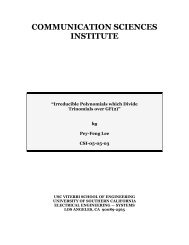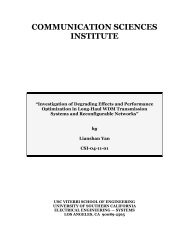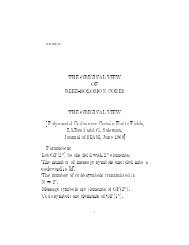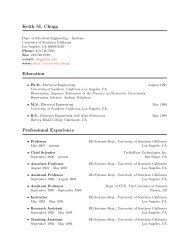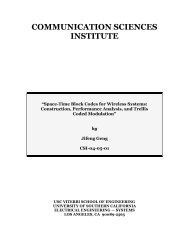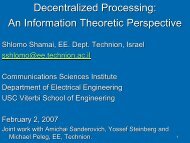Decoding Error-Correction Codes Utilizing Bit-Error Probability ...
Decoding Error-Correction Codes Utilizing Bit-Error Probability ...
Decoding Error-Correction Codes Utilizing Bit-Error Probability ...
Create successful ePaper yourself
Turn your PDF publications into a flip-book with our unique Google optimized e-Paper software.
It is first shown that X(f) is a process of orthogonal increments. Recall that a process<br />
X(f) is said to have orthogonal increments if<br />
E{|X(f 1 ) − X(f 2 )| 2 } < ∞ (2.6)<br />
and, if whenever the frequencies f 1 , f 2 , f 3 , f 4 satisfy the inequality, f 1 < f 2 < f 3 < f 4 , the<br />
correlation of the two finite increments, [X(f 1 ) − X(f 2 )] and [X(f 3 ) − X(f 4 )], satisfy the<br />
relation<br />
E{[X(f 1 ) − X(f 2 )][X(f 3 ) − X(f 4 )] ∗ } = 0, (2.7)<br />
where “ ∗ ” denotes complex conjugation (Doob [5, pg. 99]). Since X(f) exists as a limit<br />
in the mean-square sense, it is straightforward to show that equation (2.6) is satisfied. In<br />
order to verify equation (2.7), first express the integral in (2.5) more simply by<br />
X(f) =<br />
∫ ∞<br />
−∞<br />
e −i2πft − 1<br />
x(t)dt, (2.8)<br />
−2πit<br />
where it exists in the same sense that equation (2.5) exists - as a limit in the mean-square<br />
sense. Consider a finite increment in X(f), given by<br />
X(f 1 ) − X(f 2 ) =<br />
∫ ∞<br />
−∞<br />
e −i2πf1t − e −i2πf 2t<br />
x(t)dt. (2.9)<br />
−2πit<br />
Now define the real square pulse function by<br />
⎧<br />
⎪⎨ 1, f 1 < f < f 2 ,<br />
Φ f1 ,f 2<br />
(f) <br />
⎪⎩ 0, otherwise.<br />
The inverse Fourier transform of Φ f1 ,f 2<br />
(f) is given by<br />
∫ ∞<br />
−∞<br />
Φ f1 ,f 2<br />
(f)e i2πft df = ei2πf2t − e i2πf 1t<br />
, (2.10)<br />
2πit<br />
7



